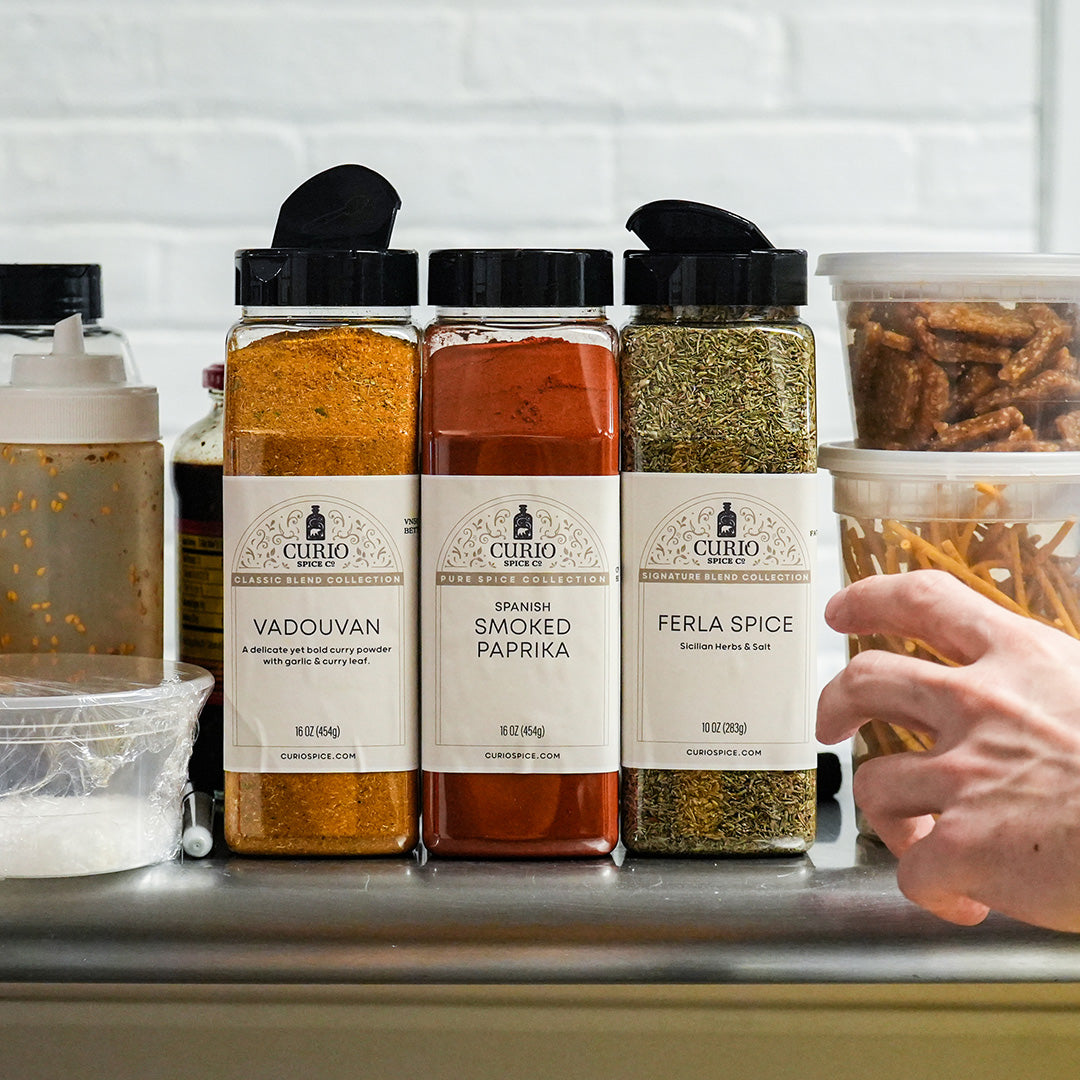Producer Spotlight: Firetongue Farms
Words by John Kilfoyle. Photos courtesy of Fire Tongue Farms.
Fire Tongue Farms is a chile pepper farm started in Hollister, CA in 2014 with the goal of growing high quality, rare chile pepper varieties for local chefs, hot sauce makers, and spice companies. They dry and smoke most of their peppers, allowing them to be more easily shipped and shelf stable, as well as giving the peppers an even more unique flavor. Fire Tongue Farms provides Curio Spice with our dried Guajillo Flakes and will soon be the producers of the japones peppers in our Edo Spice Blend. On the 23rd of August I called Levon, co-founder of Fire Tongue Farms, and talked with him about his business.
How long have you been working in the chili farming business?
The idea of Fire Tongue Farms was conceived in the fall of 2014 and in early 2015 we became a business, planted our first seeds, and got our first transplants going.
Why did you decide to start Fire Tongue Farms?
It was a confluence of a couple of ideas that both Ryan, my partner, and I had. First of all, you have to grow something that you are really passionate about. We saw an opportunity to start a business where we specialized in growing rare varieties of chili peppers that weren't commonly found. We'd been doing this on a small scale at a couple of the farms that we were studying at before.
We set out from the start to create value added products, so smoked peppers and flakes that were gonna be shelf stable. From the start we wanted to create something that's gonna be shelf stable versus being a farmer that's going to the farmer's market every week and has to deal with perishability. We were also super excited about just the totally different range of flavor profiles available through different varieties of chili peppers. We thought it was like an area that people weren't exploring and also how processing kind of brings out different flavors.We thought it was really unique and like growing things that we personally love to cook and eat and share with our friends.
Do you grow any other crops on your farm?
Commercially? No. We’ve grown a lot of cover crops and we've grown small amounts of a few other things just for fun, like tomatoes and corn. But from the business commercial perspective, it's always been about chili peppers.
It sounds like you were involved with agriculture before you started the farms.
Ryan and I both met at UC Berkeley and neither of us were studying agriculture there, but we got really interested in farming and sustainable food systems towards the end of our time in college just from the environment we were living in and some of the classes we got to take. We kind of both went off on our own ways and studied agriculture right after we left college. He went to UC Santa Cruz for a while and I studied at a few farms, one in Petaluma and a couple in Germany.And basically when I got back from Germany, we got together and we’re thinking, oh, you've been farming for a little bit. I've been farming for a bit. Why don't we start something? Let's try something small and see where it goes and here we are.

How big was your team when you started farming versus how big it is now?
Ryan and I were kind of doing everything in those early days, but had like a ton of support from our community. Especially around really big events. With two people, we were able to manage the farming aspect, sort of all on our own. Then we'd have these big s events where we'd have friends come and help us out, or we'd have some labor off and on.
Nowadays we're really focused on the processing side and we'll bring in a lot of help at the processing end at the end of the year. Things are really structured differently. Ryan's wife, Maya helps us out a lot now and there is some seasonal labor that jumps on.
You started to grow your peppers in other regions of California in 2019. How did you decide to expand your business that way?
It basically came down to not being able to grow as much as we needed, as much as our customers were asking for. People are coming to us because they really like our value added element. They're not coming to us as much for our fresh peppers. We realized that if we're gonna get more efficient and spread out our work with more new customers we really needed to double down on our processing capacities and as part of that we can't farm as much as people are asking for.
It basically came down to establishing relationships with farmers who share our approach and outlook towards farming. And we're willing to take a chance in growing some new varieties that they hadn't been growing before. We were saying, “Hey, here's this variety that you've never grown before. We'll basically have you grow it out for us and then we'll process it.”
So are these other pepper farmers or do they grow other kinds of crops
We've never worked with a farm that only does chili peppers. These are farmers who are growing anything.

You grow several kinds of peppers on your farm. How do you decide which site you'll grow each chili at? What kind of impacts do different climates have on the heat and flavor of the chilies?
This is actually one of the topics that we love to geek out on. Without going so far into it, hotter drier climates tend to lead towards concentration of capsaicin in chili peppers. So hotter drier areas lead to really spicy peppers. And then you have some of the cooler climates that we have a lot of access to in Santa Cruz which don't accumulate quite as much heat, but they end up sweeter. It’s really interesting.
For instance, we grow the Aleppo pepper in Santa Cruz because we really like how it ends up as this amazing sweet pepper that's got a great amount of heat to it as well. But when we grow that pepper in a drier climate, like Hollister, it just doesn't have quite as much sweetness to it. The cyklon pepper growing in Santa Cruz versus Hollister or Gilroy also has a similar phenomenon. If you're looking to grow a spicier pepper, Hollister is a better place to do it.
We also keep the growing season when we plant. Plants accumulate growing degree days in much faster in hot dry climates. So they'll be ripe and ready to pick and process at a much earlier date.That makes a difference with the logistics of when we need to do our processing and like how we need to sometimes stagger harvests. So sometimes if you're doing it all in one location, it's a bit harder to stretch out the harvest season, whereas, the way we have it now, it'll do like a harvest from the central valley initially and then cooler, wetter places a little later in October, even. It's a combination of factors that help us decide which varieties we want to do and where.
Are there any peppers that you're currently experimenting with as a crop or any peppers you want to try growing in the future?
This year we're growing more Super Hot Peppers than we've ever grown before. You would think from our name that we were really focused on the really spicy variety. But, you know, so for the most part in our seven years of business, we've had a nice range of peppers from the really sweet, like Jimmy Nardellos to things that start to get pretty hot like different cayenne varieties. We’ve done a lot of peppers, a lot of Mexican and New Mexican pepper, as well as Aleppo. This year we’re trying several new varieties of Super Hots, which we’re excited about and a little scared about.
But there’s never been a year where we have the same exact line up every year. There's always a few new varieties that we try out to see what we like. To see what works well in different climates. We leave some behind if we don't particularly care for them or if there's not really a market for them. And then there's a few mainstays that we have every year.
We’re also doing a couple for Curio Spice. We’re doing the Japones and also a Korean Pepper. Really excited for those.

Why did you decide to grow more Super Hot Peppers?
People were asking for them and we had space available.
What’s the hottest pepper you grow?
It's gotta be one of these new varieties we're trying but it's either the Trinidad scorpion, the ghost pepper, or the Carolina reaper. Those are weapons. It’s something else.
How do you deal with harvesting peppers that can be painfully spicy to not just taste, but touch?
It's a question I don't get that often. We do a lot of infield testing and, honestly, we'll just bite into peppers to try them. You gotta be careful harvesting, we have lots of gloves on. But we do develop a tolerance and have some yogurt ready on hand if you’re tasting several of them. The yogurt neutralizes the capsaicin. We’ve had our fair share of hiccups over the years, but most of the time it’s been okay. No one’s had eye injuries or anything like that.
What’s the hottest pepper you’ve eaten?
To this day, for some reason, the hottest I ever bit into in the field was actually a jalapeno. It was from the same row of super sweet, yummy, sugary, like barely anything peppers. And then one of them was the hottest thing I'd ever had. They'll play games on you like that.
What’s the most popular chili you grow?
The chipotle. I think we have a unique approach to our chipotle. We dry it and smoke them with fruit tree wood from local orchards. And that was one of the initial things driving us to start the business. My partner worked in a lot of organic fruit orchards that had all this excess of apple and pear and peach and plum wood and infusing that into the smoke dried peppers makes for chipotle and other smoke peppers that you weren't able to get anywhere else. It has this barbecue, sweet, smoky taste to it versus other chipotles.

A big part of your market is dried chilies. Talk to me about the drying process.
We do a combination of smoke drying and dehydration and then adding smoke afterwards.
We've had it where the fresh peppers will go into a smoker and will dry over the course of like a couple weeks. They end up very infused with smoke. What we do now is we dry them in an oven, take them to 70 to 80% dry and then finish them with smoke. So they definitely have a strong smokey flavor to them, but it's not quite as overpowering. It's a better balance.
We don't smoke all of our peppers though. The guajillo that Curio gets from us are just straight dried. One strategy to shorten the drying process is to let them dry naturally on the plants in the sun. There's a fun balance of really trying to time that and making sure that you're able to get them when they're as dry as possible without losing too much of your crop. Then we put them in the oven to finish them off.
Each variety's a little bit different. Some of the varieties are super dense, like the jalapeno has really thick walls, whereas others, like guajillo, New Mexico, Anaheim, are thinner walled and they don't need quite as much time.
What’s the typical ratio of fresh to dried chilies?
These days we're almost entirely dried and processed. We do make a few small scale products that we hope to scale up in the years to come based on just the fresh chili. So we made a really nice Aleppo hot sauce last year that people have given great reviews on. We did the same with the Cascabel chili.We did some vinegars. Most of our fresh chilies that we set aside go to those products. Then everything else is primarily being dried or smoked and sold as whole dried or as flakes and powders.
What’s your market like?
We're a combination of Business-2-Consumer and Business-2-Business, so we don't do too much retail. We'd love to work with a distributor in the future, but we’re just not really set up for that. Most of our business is through direct sales, online, and then also to companies like Curio.
Every year of course we do get some like requests from local chefs or people in our network who want like a hundred pounds here, a hundred pounds there. There are local people, like trying to start their own hot sauce company or doing their home hot sauce, they'll call us and say, Hey, can I get 50 pounds of Cayenne?
A couple times you mentioned how Santa Cruz, where you grow a lot of your peppers, has a wetter climate. I know that water is a rare resource for farms in California. How has that been an issue and how have you dealt with that?
There's a lot to say about that. Fortunately, the areas that we've been growing have water access and also our scale isn't so big. It's never been too big of a problem. With one acre of chili pepper, you could get quite a big yield if you're efficient and effective.
A lot of the farms that you hear about in the news that are having water constraints or whatever, but it's really big farms and chili peppers don't take that much water compared to other crops. One thing we've been good about from the start is really monitoring and understanding the time of the growth stage for each pepper and what we do towards the end of the season. When we see we're getting close to harvest time, we completely cut the water and do deficit irrigation, which has multiple benefits. It basically saves you water but also stresses your crops so that it concentrates its flavor, stops its vegetative growth and makes for hotter peppers.

What are your favorite recipes to make with your chilies?
We use them in everything and it really depends on the time of the year. With flakes I use it kind of like a condiment, so on eggs or burritos or pizza, anything that you're making. With whole dried peppers, one of my favorite things to use them in is a pot of beans. We use different kinds of beans, and in combination with other spices and herbs, you get a great flavor. They also go great in stews or any dishes that you're making. The smoked ones in particular totally transform the meal, whereas the non-smoked ones are great for just adding spiciness.
Do you find that you have a high tolerance for heat now that you work with and eat a lot of chilies or have you always had a high tolerance?
My tolerance has gotten better since I started. It’s probably higher than the average person but I'll still eat something and end up having the same experience as anybody else. I think I'm conscious about not overdoing it, we’re still trying to eat good food, right? And not drowning it in spiciness to the point where you can’t taste your food.
What are some of your favorite aspects about being a grower?
Being involved in farming allows you to interact with some of the most fundamental things that you do as a human on earth, like interacting with your environment, soils, and climate. I really love the philosophical or intellectual challenge of farming each year like trying to predict when things will be ready, trying to understand causal relationships.That’s something we really get enjoyment out of. No two years are the same and every year there's a new challenge, but ultimately at the end of the day that's what motivates us and keeps us going. One of the best aspects of the whole business is seeing new reactions being able to create something that people appreciate.








Great interview. I learned a lot!
Leave a comment